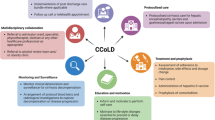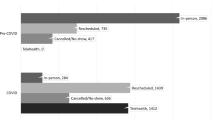Abstract
Background and Aims
To improve subspecialty access, VA Ann Arbor Healthcare System (VAAAHS) implemented the first Specialty Care Access Network (SCAN)-Extension of Community Healthcare Outcomes (ECHO) in chronic liver disease. SCAN-ECHO Liver links primary care providers (PCPs) to hepatologists via secure video-teleconferencing. We aim to describe characteristics of participants (PCPs) and patients (clinical question and diagnosis) in SCAN-ECHO Liver.
Methods
This is a prospective study of the VAAAHS SCAN-ECHO Liver (June 10, 2011–March 31, 2015). This evaluation was carried out as a non-research activity under the guidance furnished by VHA Handbook 1058.05. It was approved through the Medicine Service at VAAAHS as noted in the attestation document which serves as documentation of approved non-research, quality improvement activities in VHA.
Results
In total, 106 PCPs from 23 sites participated. A total of 155 SCAN-ECHO sessions discussed 519 new and 49 return patients. 29.4% of Liver Clinic requests were completed in SCAN-ECHO Liver. SCAN-ECHO Liver consults were completed an average of 10 days sooner than in conventional clinic. Potential travel saving was 250 miles round-trip (median 255 (IQR 142–316) per patient.
Conclusion
SCAN-ECHO Liver provided specialty care with increased efficiency and convenience for chronic liver disease patients. One of three of Liver Clinic consults was diverted to SCAN-ECHO Liver, reducing consult completion time by 20%.




Similar content being viewed by others
Abbreviations
- VHAAAHS:
-
VA Ann Arbor Healthcare System
- SCAN-ECHO:
-
Specialty Care Access Network-Extension of Community Healthcare Outcomes
- VHA:
-
Veterans Health Administration
- PCP:
-
Primary care providers
- NAFLD:
-
Nonalcoholic fatty liver disease
- CHC:
-
Chronic hepatitis C
- VISN:
-
Veterans Integrated Service Network
References
Younossi ZM, Kanwal F, Saab S, et al. The impact of hepatitis C burden: an evidence-based approach. Aliment Pharmacol Ther. 2014;39:518–531.
Rinella ME. Nonalcoholic fatty liver disease: a systematic review. JAMA. 2015;313:2263–2273.
Arora S, Kalishman S, Thornton K, et al. Expanding access to hepatitis C virus treatment–Extension for Community Healthcare Outcomes (ECHO) project: disruptive innovation in specialty care. Hepatology. 2010;52:1124–1133.
Arora S, Thornton K, Murata G, et al. Outcomes of treatment for hepatitis C virus infection by primary care providers. N Engl J Med. 2011;364:2199–2207.
Beste LA, Glorioso TJ, Ho PM, et al. Telemedicine specialty support promotes hepatitis C treatment by primary care providers in the department of veterans affairs. AJM. 2017;130:432–438.
Said A, Gagovic V, Malecki K, et al. Primary care practitioners survey of nonalcoholic fatty liver disease. Ann Hepatol. 2013;12:758–765.
Blais P, Husain N, Kramer J, Kowalkowski M, El-Serag HB, Kanwal F. Nonalcoholic fatty liver disease is underrecognized in the primary care setting. Am J Gastroenterol. 2015;110:10–14.
Davis RS, Bukstein DA, Luskin AT, et al. Changing physician prescribing patterns through problem-based learning: an interactive, teleconference case-based education program and review of problem-based learning. Ann Allergy Asthma Immunol. 2004;93:237–242.
Frank JW, Carey EP, Fagan KM, et al. Evaluation of a telementoring intervention for pain management in the Veterans Health Administration. Pain Medicine. 2015;16:1090–1100.
Salgia RJ, Mullan PB, McCurdy H, et al. The educational impact of the specialty care access network- extension of community healthcare outcomes program. Telemed E Health. 2014;20:1004–1007.
Goldberg DS, French B, Forde KA, et al. Association of distance from a transplant center with access to waitlist placement, receipt of transplantation, and survival among US veterans. JAMA. 2014;311:1234–1243.
Axelrod DA, Guidinger MK, Finlayson A, et al. Rates of solid-organ wait-listing, transplantation, and survival among residents of rural and urban areas. JAMA. 2008;299:202–207.
Hassan A, Pearce NJ, Mathers J, et al. The effect of place of residence on access to invasive cardiac services following acute myocardial infarction. Can J Cardiol. 2009;25:207–212.
Friedman SA, Frayne SM, Berg E, et al. Travel time and attrition from VHA care among women veterans: how far is too far? Med Care. 2015;53:S15–S22.
Neuhausen K, Grumback K, Bazemore A, et al. Integrating community health centers into organized delivery systems can improve access to subspecialty care. Health Aff. 2012;31:1708–1716.
Cook NL, Hicks LS, O’Malley AJ, et al. Access to specialty care and medical services in community health centers. Health Aff. 2007;26:1459–1468.
Acknowledgments
Dr. Waljee’s research is funded by a Career Development Award (CDA 11-217) from the (US Department of Veterans Affairs Health Services Research and Development Service. The contents do not represent the views of the US Department of Veterans Affairs or the US Government.
Author information
Authors and Affiliations
Contributions
LMG contributed to study concept and design, acquisition of data, analysis and interpretation of the data, statistical analysis, drafting of the manuscript, and critical revision of the manuscript for important intellectual content. AKW helped in study concept and design, statistical analysis, and critical revision of the manuscript for important intellectual content. HM contributed to acquisition of data, critical revision of the manuscript for important intellectual content. GLS contributed to study concept and design, statistical analysis, analysis and interpretation of the data, and critical revision of the manuscript for important intellectual content. AS helped in study concept and design, analysis and interpretation of the data, and critical revision of the manuscript for important intellectual content, study supervision.
Corresponding author
Ethics declarations
Conflict of interest
The authors declare that they have no conflict of interest.
Appendix
Appendix
Liver-related didactic topics presented in SCAN-ECHO Liver Clinic.
-
1.
Chronic Hepatitis C Virus Infection: Epidemiology and Natural History
-
2.
Chronic Hepatitis C Virus: Treatment of Genotype 2 and 3 Infection
-
3.
Approach to the patient with abnormal liver function tests: Part I
-
4.
Approach to the patient with abnormal liver Function Tests Part II:
-
5.
Diagnosis and Management of Ascites
-
6.
Interpretation of Hepatitis B Testing
-
7.
Liver Transplantation: Why, When and How Part I
-
8.
Liver Transplantation: Why, When and How Part II
-
9.
Interpretation of Hepatitis B Testing
-
10.
Chronic Hepatitis C: Treatment of Genotype I Infection, Treatment Naïve
-
11.
Chronic Hepatitis C: Treatment of Genotype I Infection, Treatment-experienced
-
12.
Diagnosis of Hepatocellular Carcinoma
-
13.
Hepatocellular Carcinoma: Management and Treatment
-
14.
Nonalcoholic fatty liver disease: diagnosis
-
15.
Nonalcoholic fatty liver disease: management
-
16.
Diagnosis of Management of Hepatic Encephalopathy
-
17.
Approach to Liver Mass
-
18.
Alcoholic Hepatitis: Diagnosis and Management
-
19.
Autoimmune Liver Disease
-
20.
Statins and Liver Disease
-
21.
Approach to the patient with cirrhosis
-
22.
Management of side effects HCV treatment: Dermatologic
-
23.
Management and side effect of Sorafenib treatment
-
24.
Medical care of the patient with a liver transplant: Part I
-
25.
Medical care of the patient with a liver transplant: Part II
-
26.
Hematological Abnormalities in Cirrhosis
-
27.
Diagnosis and Management of Esophageal Varices
-
28.
Optimizing Renal Function in Cirrhosis: an Act of balancing
-
29.
Management of side effects of HCV treatment: Bone Marrow Effects
-
30.
Hepatorenal Syndrome
-
31.
HIV/HCV Treatment Genotype I Protocol
-
32.
Hereditary Liver Disease
-
33.
Paracentesis
-
34.
Liver Biopsy
-
35.
Pain Management in Patients with Liver Disease
-
36.
Liver Transplantation and Hepatocellular Carcinoma
Rights and permissions
About this article
Cite this article
Glass, L.M., Waljee, A.K., McCurdy, H. et al. Specialty Care Access Network-Extension of Community Healthcare Outcomes Model Program for Liver Disease Improves Specialty Care Access. Dig Dis Sci 62, 3344–3349 (2017). https://doi.org/10.1007/s10620-017-4789-2
Received:
Accepted:
Published:
Issue Date:
DOI: https://doi.org/10.1007/s10620-017-4789-2




